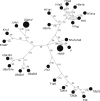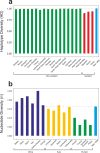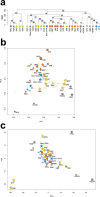Goth migration induced changes in the matrilineal genetic structure of the central-east European population
- PMID: 31043639
- PMCID: PMC6494872
- DOI: 10.1038/s41598-019-43183-w
Goth migration induced changes in the matrilineal genetic structure of the central-east European population
Abstract
For years, the issues related to the origin of the Goths and their early migrations in the Iron Age have been a matter of hot debate among archaeologists. Unfortunately, the lack of new independent data has precluded the evaluation of the existing hypothesis. To overcome this problem, we initiated systematic studies of the populations inhabiting the contemporary territory of Poland during the Iron Age. Here, we present an analysis of mitochondrial DNA isolated from 27 individuals (collectively called the Mas-VBIA group) excavated from an Iron Age cemetery (dated to the 2nd-4th century A.D.) attributed to Goths and located near Masłomęcz, eastern Poland. We found that Mas-VBIA has similar genetic diversity to present-day Asian populations and higher diversity than that of contemporary Europeans. Our studies revealed close genetic links between the Mas-VBIA and two other Iron Age populations from the Jutland peninsula and from Kowalewko, located in western Poland. We disclosed the genetic connection between the Mas-VBIA and ancient Pontic-Caspian steppe groups. Similar connections were absent in the chronologically earlier Kowalewko and Jutland peninsula populations. The collected results seem to be consistent with the historical narrative that assumed that the Goths originated in southern Scandinavia; then, at least part of the Goth population moved south through the territory of contemporary Poland towards the Black Sea region, where they mixed with local populations and formed the Chernyakhov culture. Finally, a fraction of the Chernyakhov population returned to the southeast region of present-day Poland and established the archaeological formation called the "Masłomęcz group".
Conflict of interest statement
The authors declare no competing interests.
Figures







Similar articles
-
Ancient DNA reveals prehistoric gene-flow from siberia in the complex human population history of North East Europe.PLoS Genet. 2013;9(2):e1003296. doi: 10.1371/journal.pgen.1003296. Epub 2013 Feb 14. PLoS Genet. 2013. PMID: 23459685 Free PMC article.
-
Ancient DNA analysis might suggest external origin of individuals from chamber graves placed in medieval cemetery in Pień, Central Poland.Anthropol Anz. 2017 Dec 1;74(4):319-337. doi: 10.1127/anthranz/2017/0727. Epub 2017 Aug 11. Anthropol Anz. 2017. PMID: 28799621
-
Ancient genomes suggest the eastern Pontic-Caspian steppe as the source of western Iron Age nomads.Sci Adv. 2018 Oct 3;4(10):eaat4457. doi: 10.1126/sciadv.aat4457. eCollection 2018 Oct. Sci Adv. 2018. PMID: 30417088 Free PMC article.
-
Genetic Structure of the Armenian Population.Arch Immunol Ther Exp (Warsz). 2016 Dec;64(Suppl 1):113-116. doi: 10.1007/s00005-016-0431-9. Epub 2017 Jan 12. Arch Immunol Ther Exp (Warsz). 2016. PMID: 28083603 Review.
-
The evolutionary history of human populations in Europe.Curr Opin Genet Dev. 2018 Dec;53:21-27. doi: 10.1016/j.gde.2018.06.007. Epub 2018 Jun 28. Curr Opin Genet Dev. 2018. PMID: 29960127 Review.
Cited by
-
Genetic history of East-Central Europe in the first millennium CE.Genome Biol. 2023 Jul 24;24(1):173. doi: 10.1186/s13059-023-03013-9. Genome Biol. 2023. PMID: 37488661 Free PMC article.
-
Human AGEs: an interactive spatio-temporal visualization and database of human archeogenomics.Nucleic Acids Res. 2023 Jul 5;51(W1):W269-W273. doi: 10.1093/nar/gkad428. Nucleic Acids Res. 2023. PMID: 37216609 Free PMC article.
-
Maternal Lineages of Gepids from Transylvania.Genes (Basel). 2022 Mar 23;13(4):563. doi: 10.3390/genes13040563. Genes (Basel). 2022. PMID: 35456371 Free PMC article.
-
Holocene vegetation, fire and land use dynamics at Lake Svityaz, an agriculturally marginal site in northwestern Ukraine.Veg Hist Archaeobot. 2022;31(2):155-170. doi: 10.1007/s00334-021-00844-z. Epub 2021 Jun 21. Veg Hist Archaeobot. 2022. PMID: 35273429 Free PMC article.
-
Genetic continuity of Indo-Iranian speakers since the Iron Age in southern Central Asia.Sci Rep. 2022 Jan 14;12(1):733. doi: 10.1038/s41598-021-04144-4. Sci Rep. 2022. PMID: 35031610 Free PMC article.
References
-
- Reich, D. Who We Are and How We Got Here. (Oxford University Press, 2018).
Publication types
MeSH terms
Substances
LinkOut - more resources
Full Text Sources


